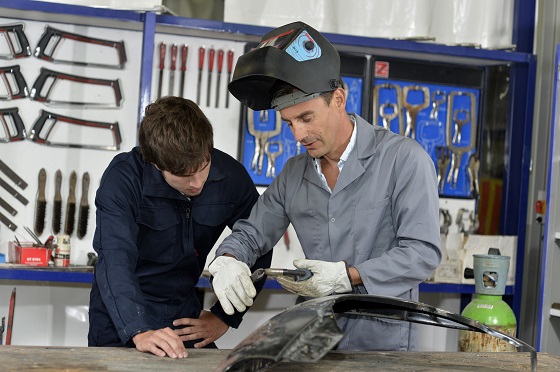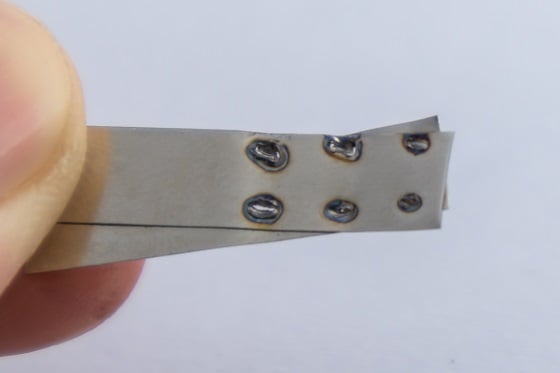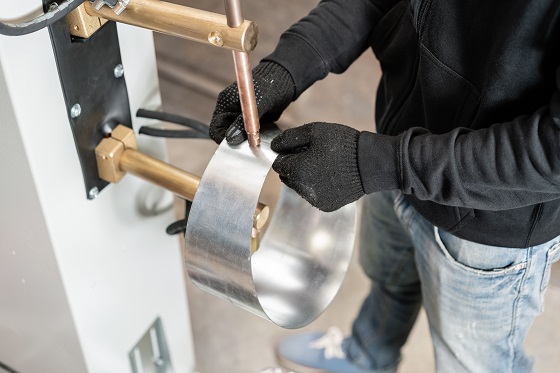What is spot welding? An instructor’s overview of resistance spot welding.
The following article about resistance spot welding, the first of many such guides, is presented in the form of a training session.
It features the Company’s Instructor, Tom, and the young apprentice, Paul, who has just entered the Welding Division.
Paul is keen to learn all he can about the different welding processes, how they work, what they are used for and what problems can arise.

In this first one, we see Tom describing one of the simpler and yet still widely used processes.
We will cover the below points:
- What is spot welding?
- How does spot welding work?
- How strong is a spot weld?
- What is a spot welder used for?
- Spot welding problems.
Tom, “This morning we are going to look at resistance spot welding.
The first thing is to understand exactly what the process is and what it does. It is one of the older welding processes that is still used widely today across several industrial sectors.
These are primarily sheet metal applications such as the automotive and aerospace industry, the white goods sector (i.e. domestic items such as refrigerators and washing machines), steel furniture (filing cabinets and storage cupboards) and, at the other end of the scale, electronics.
Paul, “How does spot welding work?”
Tom, “Resistance spot welding is an electric welding process where the heat required to melt and to join the pieces of metal together is generated by the electrical resistance between the two sheets.
Typically, this is done by applying high pressure between two electrodes. One on either side of the sheet, and then an extremely high current is then passed through the circuit.
The two electrodes are made from a copper alloy and this alloy has a very low resistance to the passage of the current, enabling the heat to be concentrated between the two electrodes.
The electrical current only runs for a short time because, once the pieces of metal fuse together, the current is no longer needed.
However, the electrodes continue applying pressure until the melted metal solidifies into a secure joint.
Welds created through this process are typically between 3 and 12.5 millimetres in diameter, with the size affecting the strength of the joint created.
The welds are repeated at regular intervals to effectively join the two pieces.
Paul, “How do the electrodes apply the pressure to create the spot weld?”
Tom, “There are basically two different ways. The most common is in the form of a gun which is operated by compressed air.
When the trigger is pulled, the air forces the two arms of the gun together, thereby squeezing the two sheets together.
Typically, a gun will be mounted on an overhead pulley so that it can be easily manipulated around the workpieces.
Increasingly, in industries such as the automotive sector, the spot welding gun is mounted on the arm of a robot which manipulates the gun in much the same way as a human being would but, obviously much quicker.
The second way is by means of a pedestal welder, where the two arms are mounted in a steel frame and the workpieces are then manipulated accordingly.
In the first type, the gun is manipulated around the workpiece – for example around a car body but, in the second case, which is for smaller parts, the workpieces are manipulated through the gap between the electrodes.

There is a third variation and that is seam welding – often used for sealing the joint around a product such as a fuel tank. Here instead of using two electrodes, a pair of revolving wheels is used to apply both the pressure and the electrical current.
Paul, “You mention the electrodes. What are they made of and how big are they?”
Tom, “The electrodes are made of a cast copper alloy in cylindrical rod form.
Depending upon the application they are designed to produce a spot weld of between 3mm and 12.5mm in diameter; the diameter will affect the strength of the final weld.
Typically, the end is machined to a taper with a flat top.
Depending upon the application, they will need dressing regularly to preserve the weld integrity.
Before the intervention of the welding robot, the accuracy of the line of welds around a structure such as a car body was entirely dependent upon the skill of the human being behind the gun.
Even though the gun is hanging from a balance, it is still tiring pulling, manipulating, and pushing the gun around over an 8-hour shift.
Hence the increasing application of welding robots.
Paul, “Can you weld any material using spot welding and how thick can you go?”
Tom, “The most used material is steel because of its low thermal conductivity and high electrical resistance.
For many years, particularly in the automotive industry, the steel sheets were just a simple, low carbon steel. But, as the pressure grew for better performance and improved fuel consumption, the industry began to use higher strength steels.
Until the 1960s, the typical car body would be made of low carbon steel sheets and pressings between 0.75mm and 3mm thick (30-120thousandths of an inch).
However, by the 1970s, these thicknesses were reducing as increased use of higher strength steel was introduced.
It is not only low carbon steel that can be spot welded, however.
Again, going back to the late 1960s, the chassis of the Leyland single-decker bus was made from low alloy steel. Typically this had been riveted but this was changed to spot welding with massive guns welding up to two pieces of 9mm material.
Stainless steel, titanium, nickel, and its alloys can all be spot welded. Galvanised steel sheet – again typically used on car underframes and sills, can be spot welded but it requires higher welding current and, quite often, can lead to weld metal being ejected from the weld.
Plastic is another material that can be spot welded, although with smaller guns!
Paul, “What are the advantages of spot welding?”
Tom, “Unlike for example, arc welding where the whole emphasis is on critical accuracy, spot welding is far more tolerant of the skill of the operator.
Welds are generally made along a reasonably wide flange, giving the operator a little bit more room to get his gun in the correct position.
Spot welding creates reliable results, forming welds that last.
Because spot welding uses an electrical current running through electrodes, it doesn’t require metal weld material.
It’s a quick process, which makes your projects run smoothly.
The large amount of energy lets the weld happen without applying too much heat to other areas of the metal.
Paul, “OK, so what are the disadvantages?”
Tom, “This method of resistance welding doesn’t work well for all types of metal, so it may limit the options on your projects.
If the current or heat isn’t strong enough, the joint may not hold well over time.
So getting the correct settings is important.
It can also be challenging to position the electrodes well on odd-shaped projects or in difficult-to-reach spots.
Next time, we will take a look at welding stainless steel.
If you have found this Q&A feature on spot welding interesting, you will find many more articles on The Welding Institute’s website here.
The TWI are a technology and research centre providing expert advice on all welding, joining and engineering technologies.
Looking for spot welding machinery? Find new and used spot welders for sale here.
Rodney Pitt, Author and an erstwhile Editor of Welding Review, Welding & Metal Fabrication and Metal Construction.

